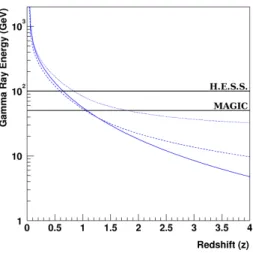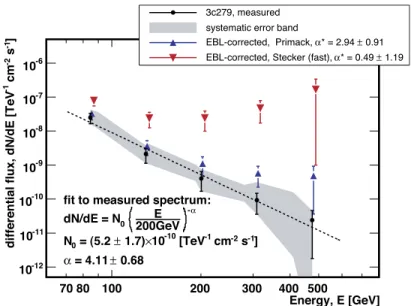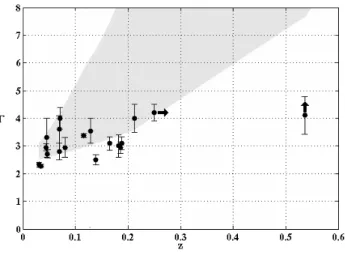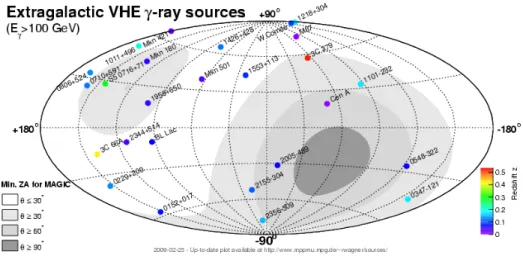THE MAGIC EXTRAGALACTIC SKY
BARBARA DE LOTTO (on behalf of the MAGIC Collaboration) University of Udine and INFN, Sezione di Trieste
Italy
The MAGIC telescope, with its 17-m diameter mirror, is currently the largest single-dish Imaging Air Cherenkov Telescope. It is located on the Canary Island La Palma, at an al- titude of 2200 m above sea level, and is operating since 2004. The accessible energy range is in the very high energy (VHE, E > 100 GeV) gamma-ray domain, and roughly 40% of the duty cycle is devoted to observation of extragalactic sources. Due to the lowest energy threshold (25 GeV), it has the largest optical depth, and it is thus well suited for extragalactic observations. The strategies of extragalactic observations by MAGIC are manifold: long time monitoring of known TeV blazars, detailed study of blazars during flare states, multiwave- length campaigns on most promising targets, and search for new VHE γ-ray emitters. In this talk, highlights of observations of extragalactic objects will be reviewed.
1 Introduction
One of the major goals of ground-based γ-ray astrophysics is the study of VHE γ-ray emission from active galactic nuclei (AGN). Except for the radio galaxies M87 and Centaurus A, all currently known VHE γ-ray emitters in the extragalactic sky are BL Lac objects. The sensi- tivity of the current Imaging Atmospheric Cherenkov Telescopes (IACT) has recently enabled detailed studies of these sources in the VHE γ-rays domain, providing information for advances in understanding the origin of the VHE γ-rays, as well as powerful tools for fundamental physics studies 1 .
The IACT technique 2 uses the atmosphere as a calorimeter to detect the extensive air shower produced after the interaction of a VHE γ-ray. The charged particles (mainly electrons and positrons) in the air shower produce Cherenkov light that can be easily detected in the ground with photomultipliers. A Cherenkov telescope uses a large reflector area to concentrate as much as possible of these photons and focus them to a camera where an image of the atmospheric cascade is formed. By analysing this image it is possible to reconstruct the incoming direction and the energy of the γ -ray. The analysis of the images is also used to reject the much higher background of cosmic rays initiated showers.
In this paper selected results on extragalactic observations with MAGIC are presented.
2 The MAGIC telescope
MAGIC 3,4 , located on the Canary Island of La Palma (2200 m a.s.l.), is currently the largest
(17-m diameter) single-dish IACT. Due to its large collection area and uniquely designed camera,
MAGIC has reached the lowest energy threshold (trigger threshold 50–60 GeV at small zenith
angles, new trigger for pulsar observations ∼ 25 GeV 5 ) for γ -ray emission among the existing terrestrial γ-ray telescopes.
MAGIC has a sensitivity of ∼ 1.6% of the Crab Nebula flux in 50 observing hours. Its energy resolution is about 30% above 100 GeV and about 25% from 200 GeV onwards. The angular resolution is 0.1 deg. The MAGIC standard analysis chain is described, e.g., in Albert et al. 6 . Observations during moderate moonshine enable a substantially extended duty cycle, which is particularly important for blazar observations. Parallel optical R-band observations are performed by the Tuorla Blazar Monitoring Program with its KVA 35-cm telescope.
A second MAGIC telescope is being commissioned 7 , which is improving the sensitivity to
∼ 0.8% of Crab in 50 hours.
3 The propagation and absorption of γ -rays
While travelling long distances without deviations in the fields, VHE γ-rays suffer the absorption losses due to the interaction with the low energy photons from the extragalactic background light (EBL), limiting the distance to the source that could be detected. The standard process is γ V HE γ EBL → e + e − pair production. The corresponding cross section 8 reaches its maximum, σ γγ max ' 1.70 · 10 −25 cm 2 , assuming head-on collisions, when the background photon energy is (E) ' (0.5 TeV/E) eV, E being the energy of the hard (incident) photon. This shows that in the energy interval explored by the IACTs, 50 GeV < E < 100 TeV, the resulting opacity is dominated by the interaction with infrared/optical/ultraviolet diffuse background photons (EBL), with 0.005 eV < < 10 eV, corresponding to the wavelength range 0.125 µm < λ <
250 µm.
Based on synthetic models of the evolving stellar populations in galaxies as well as on deep galaxy counts (see, for a review, 9 ), several estimates of the spectral energy distribution (SED) of the EBL have been proposed, leading to different values for the transparency of the universe to 50 GeV < E < 100 TeV photons 10 ; the resulting uncertainties are large.
Because of the absorption produced by the EBL, the observed photon spectrum Φ obs (E 0 , z) is related to the emitted one Φ em (E(z)) by
Φ obs (E 0 , z) = e −τγ(E
0,z) Φ em (E 0 (1 + z)) , (1) where E 0 is the observed energy, z the source redshift and τ γ (E 0 , z) is the optical depth 11 .
The energy dependence of τ leads to appreciable modifications of the observed source spec- trum (with respect to the spectrum at emission) even for small differences in τ , due to the exponential dependence described in Eq. (1). Since the optical depth (and consequently the absorption coefficient) increases with energy, the observed flux results steeper than the emitted one. The horizon (e.g. Ref. 12,13 ) for a photon of energy E is defined as the distance correspond- ing to the redshift z for which τ (E, z) = 1, which gives an attenuation by a factor 1/e (see Fig. 1). MAGIC has the lowest energy threshold, and thus is currently the best suited telescope to look farther away.
4 Multi-Wavelength Campaigns
Coordinated simultaneous multi-wavelength observations, yielding spectral energy distributions
(SED) spanning over 15 decades in energy, have been recently conducted, and turn out to be es-
sential for a deeper understanding of blazars. MAGIC participated in a number of multiwavelength-
campaigns on known northern-hemisphere blazars, which involved the X-ray instruments Suzaku
and Swift, the γ -ray telescopes H.E.S.S., MAGIC and VERITAS, and other optical and radio
telescopes.
Figure 1: Gamma-ray horizon compared with the lower energy limit of the MAGIC and H.E.S.S. Cherenkov telescopes; the curves of the photon energy versus horizon are computed for different background evolution
models by Blanch & Martinez in Ref.
12.
• Mkn 421 was detected in two campaigns during outbursts in 2006 and 2008; the coordinated effort allowed for truly simultaneous data from optical to TeV energies, and studies of correlations between the different energy bands 14,15 .
• The VHE emission of PG 1553+113 showed no variability during the first multi-wavelength campaign on this blazar in July 2006 16,17 ; it was observed simultaneously for the first time together with AGILE during 2008 18 .
• 1ES 1959+650 showed VHE data among the lowest flux state observed from this object, while at the same time a relatively high optical and X-ray flux (both Swift/Suzaku) was found 19 . The SED could be modeled assuming a one zone SSC model, using parameters similar to the ones needed for the SED measured in 2002.
• Also campaigns on 1ES 1218+304 and 1H 1426+428 have been carried out, during both of which significant X-ray variability has been observed. The VHE data are being analyzed.
Further campaigns have been and will be organized in the future.
5 Strong Flaring of Messier 87 in February 2008
M 87 is the first non-blazar radio galaxy known to emit VHE γ-rays, and one of the best-
studied extragalactic black-hole systems. To enable long-term studies and assess the variability
timescales and the location of the VHE emission in M 87, the H.E.S.S., MAGIC and VERITAS
collaborations established a regular, shared monitoring of M 87 and agreed on mutual alerts in
case of a significant detection. During the MAGIC observations, a strong signal of 8 σ significance
was found on 2008 February 1 st , triggering the other IACTs as well as Swift observations. The
analysis revealed a variable (significance: 5.6 σ) night-to-night γ -ray flux above 350 GeV, while
no variability was found in the 150–350 GeV range 21 . The E > 730 GeV short-time variability
of M 87 reported by 20 has been confirmed. This fastest variability ∆t observed so far in TeV
γ-rays in M 87 is on the order of or even below one day, suggesting the core of M 87 as the origin
of the TeV γ-rays. M 87 is the first radio galaxy that shows evidence for a connection between
simultaneously and well sampled radio and VHE flux variations, opening a new avenue for the
study of AGN accretion and jet formation 22 .
6 Blazars Detected during Optical Outbursts
MAGIC has been performing target of opportunity observations upon high optical states of known or potential VHE γ-ray emitting extragalactic sources. Up to now, this strategy has been proven very successful, with the detection of Mkn 180 23 , 1ES 1011+496 24 , and recently S5 0716+71 25 (paper in preparation).
In April 2008, KVA observed a high optical state of the blazar S5 0716+71, triggering MAGIC observation, which resulted in a detection of a strong 6.8 σ signal, corresponding to a flux of F >400GeV ≈ 10 −11 cm −2 s −1 . The MAGIC observation time was 2.6 h. The source was also in a high X-ray state 26 .
The determination of the before-unknown redshifts of 1ES 1011+496 (z = 0.21) 24 and S5 0716+71 (z = 0.31) 27 makes these objects the third-most and second-most distant TeV blazars after 3C 279, respectively.
7 The region of 3C66A/B
The MAGIC telescope observed the region around the distant blazar 3C 66A for 54.2 h in August–December 2007. The observations resulted in the discovery of a γ -ray source centered at celestial coordinates R.A. = 2 h 23 m 12 s and decl.= 43 ◦ 0. 0 7 (MAGIC J0223+430), coinciding with the nearby radio galaxy 3C 66B 28 . The energy spectrum of MAGIC J0223+430 follows a power law with a normalization of (1.7 ± 0.3 stat ± 0.6 syst ) × 10 −11 TeV −1 cm −2 s −1 at 300 GeV and a photon index Γ = −3.10 ± 0.31 stat ± 0.2 syst . A possible association of the excess with the blazar 3C 66A and nearby radiogalaxy 3C 66B is discussed in these proceedings 29 .
8 Detection of the flat-spectrum radio quasar 3C 279
Observations of 3C 279, the brightest EGRET AGN 30 , during the WEBT multi-wavelength campaign 31 revealed a 5.77 σ post-trial detection on 2006 February 23 rd supported by a marginal signal on the preceding night 32 . The overall probability for a zero-flux lightcurve can be rejected on the 5.04 σ level. Simultaneous optical R-band observations by the Tuorla Observatory Blazar Monitoring Program revealed that during the MAGIC observations the γ-ray source was in a generally high optical state, a factor of 2 above the long-term baseline flux, but with no indication of short time-scale variability at visible wavelengths. The observed VHE spectrum can be described by a power law with a differential photon spectral index of α = 4.1± 0.7 stat ±0.2 syst between 75 and 500 GeV (Fig. 2). The measured integrated flux above 100 GeV on February 23 rd is (5.15 ± 0.82 stat ± 1.5 syst ) × 10 −10 photons cm −2 s −1 .
This detection extends the test on the transparency of the universe up to z = 0.536; the γ-ray horizon together with the IACT measurements is shown in Fig. 3 from 32 .
VHE observations of such distant sources were until recently impossible due to the expected strong attenuation of γ rays by the EBL, which influences the observed spectrum and flux, resulting in an exponential decrease with energy and a cutoff in the γ -ray spectrum. The recon- structed intrinsic spectrum is difficult to reconcile with models predicting high EBL densities, while low-level models, e.g. 10 , are still viable. Assuming a maximum intrinsic photon index of α ∗ = 1.5, an upper EBL limit is inferred, leaving a small allowed region for the EBL.
In Fig. 4 the observed values of the spectral indexes of the blazars detected so far in VHE
band are shown, together with the prediction (light grey area) of the standard scenario. The
recent findings suggest a higher transparency of the universe to VHE photons than expected
from current models of the EBL, and could be interpreted in terms of more exotc scenarios 34 .
Energy, E [GeV]
70 80 100 200 300 400 500
]
-1s
-2cm
-1differential flux, dN/dE [TeV
10
-1210
-1110
-1010
-910
-810
-710
-6fit to measured spectrum:
α -
200GeV E dN/dE = N
0-1
]
-2
s
-1
cm [TeV 10
-10× 1.7)
± = (5.2 N
00.68
± = 4.11 α
3c279, measured systematic error band
0.91
±
* = 2.94 α EBL-corrected, Primack,
1.19
±
* = 0.49 α EBL-corrected, Stecker (fast),
Figure 2: Spectrum of 3C 279 measured by MAGIC. The grey area includes the combined statistical (1σ) and systematic errors, and underlines the marginal significance of detections at high energy. The dotted line shows compatibility of the measured spectrum with a power law of photon index α = 4.1. The blue and red triangles
are measurements corrected on the basis of the two models for the EBL density.
Redshift z
0 0.1 0.2 0.3 0.4 0.5 0.6 0.7
Gamma-Ray Energy [TeV]
10
-210
-11 10
Energy Threshold of MAGIC
Primack et al. (2005) Kneiske et al. 2002 (modified)
Opacity For Gamma Rays τ > 1
Stecker et al. (2006)
Mkn 501
1ES 0229+200 H 1426+428
1ES 1101-2321ES 0347-121 1ES 1011+496
3C 279 τ = 5 τ = 2 τ = 1



